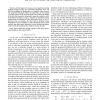Free Online Productivity Tools
i2Speak
i2Symbol
i2OCR
iTex2Img
iWeb2Print
iWeb2Shot
i2Type
iPdf2Split
iPdf2Merge
i2Bopomofo
i2Arabic
i2Style
i2Image
i2PDF
iLatex2Rtf
Sci2ools
GLOBECOM
2008
IEEE
2008
IEEE
GLRT-Based Spectrum Sensing for Cognitive Radio
—In this paper, we propose several spectrum sensing methods designed using the generalized likelihood ratio test (GLRT) paradigm, for application in a cognitive radio network. The proposed techniques utilize the eigenvalues of the sample covariance matrix of the received signal vector, taking advantage of the fact that in practice, the primary signal in a cognitive radio environment will either occupy a subspace of dimension strictly smaller than the dimension of the observation space, or have a spectrum that is non-white. We show that by making various assumptions on the availability of side information such as noise variance and signal space dimension, several feasible algorithms result which all outperform the standard energy detector.
Cognitive Radio | GLOBECOM 2008 | Signal Space Dimension | Spectrum Sensing Methods | Telecommunications |
| Added | 29 May 2010 |
| Updated | 29 May 2010 |
| Type | Conference |
| Year | 2008 |
| Where | GLOBECOM |
| Authors | Teng Joon Lim, Rui Zhang, Ying-Chang Liang, Yonghong Zeng |
Comments (0)

